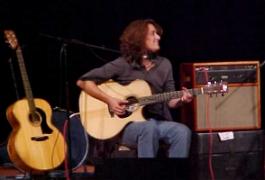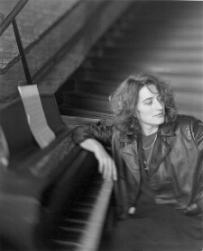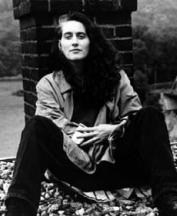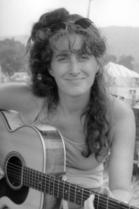 You write about your original bluesy style...
You write about your original bluesy style...
Louise Taylor is "constantly trying to cover new ground." Not the distance she drove today from Vermont to Ventnor, but the artistic ground borne out by tonight's sampling from four fine, varied records.
A small crowd waits outside the sanctuary. Louise eats Chinese, chatting graciously. A local rag tagged Taylor the pick of the week, but talk of snow has held down attendance.
As is customary, a Plover opens the show; tonight the crowd is favored with renditions of "What Are You Doing for the Rest of Your Life?," "Malaguena," and some originals. Reverend Clancy offers a farewell to the series, moving soon to fancier digs. The concert begins.
Louise finds a soulful groove right away with Ray Bonneville's "Two Bends in the Road," about distance in a relationship.
 You write about your original bluesy style...
You write about your original bluesy style...
Early on, I listened to Van Morrison, Bonnie Raitt, and Leon Russell. I still feel music with a groove, a slow groove, but definitely a groove.
Taylor follows with "Miriam Bell" a dark, Appalachian-flavored story in DADGAD.
The liner notes to Written in Red mention cultural influences "from three tours of Ireland."
That record showcases my interest in Appalachian, traditional, and Celtic music. Touring Ireland, I heard how their music was like the blues. I realized, over there Kelly Jo Phelps was almost playing Irish stuff. I wanted to write in a traditional style to show the combination. I started finger picking, simple Travis picking with bare fingers. You get in a lot closer and start hearing and feeling things differently. From that came "My Dove," "Gunny Hole" and "Miriam Bell."
Chris Smither's influence?
I realized you don't have to fill in all the blanks. I'd been mostly a strummer; Chris and Ray Bonneville - both finger style people though quite different - each get a great groove going by allowing more space. That can only happen with finger work.
The finger picking accentuates the lovely midrange of Louise's Froggy Bottom guitar.
I have five. Michael Millard is one of the best luthiers in the world. I had this one made before I married the man. On the road with me since 1991 and it has held up beautifully. Longer than the marriage... We're still friends. Please mention they're raffling off a guitar this month to benefit a local school.
Louise retunes for some trademark strumming in Jesse Winchester's blues gospel "Let's Make a Baby King," from Signature's compilation Wonderland.
 Essential to your groove is syncopated strumming...
Essential to your groove is syncopated strumming...
I use my palm to muffle the strings, pulling off and on, creating a certain rhythm and a sound, too, fattening up the strings.
How did learning African drumming translate to guitar?
I didn't gain great facility, but it helped me understand having more than one feel going at once. They'll play in three or six or four, so you hear rhythm broken up differently. That's what makes the music swing, moving from side to side rather than straight.
Where can I hear that?
"Call My Name"...
...from the soon-to-be-released Velvet Town and the next tune--funky picking with a terrific bass line and a strip of paper woven between the strings...
I'm playing in a percussive style that almost sounds like an African instrument.
Learning to work my bare thumb, I found this little back porch groove that started to evolve. I got to play it on dobro, which turned out more like I wanted. I rolled paper between the strings and found the sound.
Same piece of paper each time?
(laughing) New paper...
Louise retunes again...
Is a song the impetus for a tuning or vice versa?
Both things happen.
I've searched for a tuning. For "Deep Dark River" -- an Appalachian horror story of incest, rape, and murder (laughing)--I searched, then ended up making a tuning. Very dark. C A# C G A# C, I think.
 And introduces "Velvet Town."
And introduces "Velvet Town."
"The Connecticut River," she explains, "separates Vermont and New Hampshire--and rightly so. Brattleboro was built facing away from the river… and New Hampshire. The river and city lend light to the evening sky, a velvety blue green almost surreal."
With a sensual vocal and a lick reminiscent of Hendrix' "Waterfall," Louise sings about "the blacktop steaming" and "the streets… naked… clean for a change" and a warning that "the heat could make me say things."
You hitchhiked around for seven years... where does that turn up?
I learned about people... Still do, on the road. And I often explain things through landscapes. That's from traveling, too.
Velvet Town?
It's the title track because it marked going somewhere else. It's about love.
Taylor ends the set with "Something Like This" the Velvet Town opener.
To my ears the new record is a departure.
I was scared like it was a departure. When I presented this material to the label, I also had another fifteen folkier songs. They liked those songs. But I said," I like these." We questioned it. But that's what's great about Signature; they let me do it.
It is more challenging.
I've always done what I thought was good and people have responded. I think the songs work together well as a collection.
How did this departure happen?
 I wanted a broader variety vocally. That meant doing different things tonally. I made the melodies deeper to allow myself to sing more. I stripped back the lyrics, leaving a little less to work with, more space.
I wanted a broader variety vocally. That meant doing different things tonally. I made the melodies deeper to allow myself to sing more. I stripped back the lyrics, leaving a little less to work with, more space.
I've been touring with a percussionist, Dean Sharp, extremely accomplished. I started to hear what was possible, different grooves. I also wanted to write music interesting for him. I stripped back the guitar to allow room for us to play against each other.
That's where those songs came from. They're passionate songs, passionate about life and love (laughing).
People will label the record "jazzier" but that's not really true. Each song...
Is its own little world...
Exactly...
"If I Had My Dream" opens the second set, played in standard tuning and sung without the vocal attack of the recording.
I kept hearing Billie Holiday on the record...
I've been listening to a lot of female singers who probably listened to Billie Holiday, Nina Simone, Betty Carter, Gloria Bosman-- an African jazz singer--a record by Llhasa (Lhasa de Sela, a Canadian singer who grew up traveling through Mexico on a school bus.) a very passionate record.
Sliding between notes and playing with pitch...
Definitely. I'm pulling a lot of notes into a blue area, making them wider, more dramatic, almost singing in quartertones or microtones… It was a little scary, hoping my ear was good enough to pull it off. That's where you're hearing the Billie Holiday, wider notes. She pulled things just below and made the note waver, creating the sensation of hearing the note in more than one place.
"Maria" showcases Louise's long, fine fingers. "Maps of Venice" is prefaced with a story of traveling to Italy with her dad to the hill he assaulted in World War II. A very soulful version of "Cherry Tree" precedes "Dangerous" (from "Ruby Shoes") with a lively interplay between bass and treble.
William Ackerman, the founder of Windham Hill, produced "Ruby Shoes"...
A wonderful person, a neighbor, a friend. No longer owns Windham Hill, but still very alive with music. He heard me play and was interested in doing a record. He had a brand new studio.
Next is "Gunny Hole", another Appalachian inspired tale of death. Louise plays the requested "Blue Norther," inspired by waitressing on San Padre Island, and closes-fittingly--with "Strike the Set," with a bossa nova beat and tropical scatting to make Jobim proud.
The encore, "Roll Away Car," beginning "at the lost church" ends Taylor's concert, but not her evening. There's equipment to break down, people to chat up, and an interview.
© 2003 David Kleiner
Here's a discography for Louise Taylor:
For more information, see Louise Taylor’s website at www.louisetaylor.com.